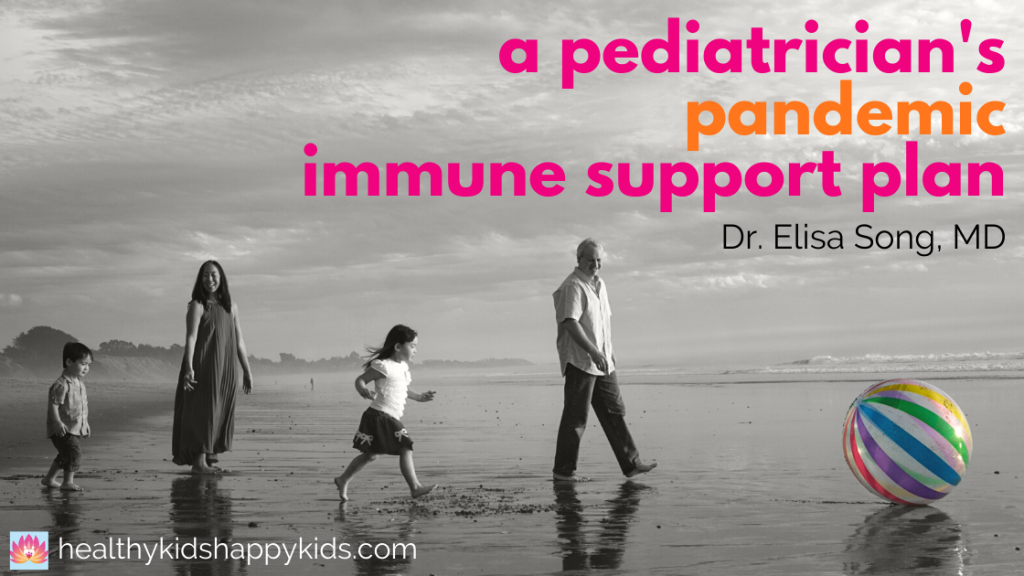
Many of you have asked me how to support your family’s immune systems with back-to-school during the pandemic. And many of you want to know specifically what I’ve been doing as a holistic pediatrician and mama, for my very own family, so I’m going to share it all!
Current estimates are that by the time the COVID-19 pandemic has run its course, 40-70% of us will contract COVID-19. I am NOT telling you this to scare you. I AM telling you this to remind you that with all the data we have to date, we still know that over 80% of people in general, and over 94% of children with COVID-19 have mild to moderate symptoms. Instead of asking what the risk factors are for getting seriously ill or even dying, let’s change the question and ask instead:
What can we do NOW to make our immune systems so resilient that we become the 80% or more that recovers rapidly and completely, EVEN if we get sick?
Back in March 2020, before we even knew what Multisystem Inflammatory Syndrome in Children (MIS-C) was, my son, Bodi, was hospitalized with all the signs of heading toward MIS-C. But thankfully, I was prepared with all the research I had done for my article that I published in February 2020, Coronavirus (COVID-19): What a Pediatrician Wants You to Know – the first article to be written on an integrative and functional medicine approach to COVID-19 even before it was called COVID-19. I absolutely believe that an integrative & functional medicine approach made a HUGE difference for Bodi’s rapid and complete recovery from potential MIS-C – he was literally weaned off of oxygen and home in 36 hours, bouncing around ready for the Easter Bunny like nothing had ever happened.
Remember – Immune Resilience is NOT about never getting sick. It’s about bouncing back quickly and completely, and being even stronger for the next hit.
Here’s my pandemic immune support plan in a nutshell:
- Priority #1: Optimize Diet & Lifestyle
- Priority #2: Harness the Power of Food as Medicine
- Priority #3: Use Targeted Nutritional Supplements
Yes, food is the priority, not supplements. Why? Because:
- Food really is medicine;
- It’s almost impossible to overdose on a particular vitamin or mineral by eating real food; and
- Some of the supplements I recommend are already sold out everywhere. While we do have most of the supplements I discuss in stock, we are quickly running out, and many are on backorder from manufacturers. So please, DON’T PANIC! Even without supplements, there are so many ways to support your family’s immune system during the Coronavirus pandemic.
The Foundations of a Healthy Immune System
The foundations of a healthy immune system start with a healthy diet and lifestyle. Bottom line …
You can’t out-supplement an unhealthy diet and lifestyle.
As we watch the world seemingly collapse, many of us are feeling like sitting ducks, powerless to do anything but wash our hands and social distance. It’s time to take back our power. Now more than ever, we have the power to make informed decisions that support our family’s health. We have the time and ability to get back to the fundamentals of optimal health – DIET & LIFESTYLE. While we’re sheltering at home, this is OUR opportunity to learn how to cook real food, sit down together for family meals, get fresh air and move our bodies everyday, get enough sleep, enjoy those extra cuddles and snuggles, and be grateful for the love and connections that we have with our family, friends, and communities.
So take the time NOW to establish healthy habits for a lifetime, and start with these foundational “musts” for any immune support plan.
- Avoid simple sugars and processed/junk food. Did you know that within 30 minutes of eating simple sugars (like glucose, refined sugar, and fructose), the ability of your white blood cells (called macrophages) to “eat up” viruses and bacteria that are trying to invade DECREASES by 50%! And that effect lasts for at least 5 hours (1)! Keeping blood sugar levels healthy has been shown to improve immune system activity, so please, if you’re stressed and need a sweet treat, don’t reach for that pint of ice cream – reach for even sweeter hugs and cuddles instead.
- Eat lots of colorful fruits and vegetables. When we get infections, it’s NOT the bug that makes us feel sick. It’s our own immune response with increased oxidative stress and free radicals that make us feel so awful. Each color provides different antioxidant power to mop up those free radicals, and help us feel better faster – so be sure to eat a rainbow every day. If your kids aren’t the biggest vegetable eaters yet, give them their antioxidant dose with a smoothie packed with fruits AND veggies, use that smoothie to make jello with grass-fed gelatin or popsicles, sneak pureed vegetables into your spaghetti sauce, soups, chilis, or whatever other way you can think of – be creative!
- Load up on foods and spices with antiviral properties. These include coconut oil, raw garlic, thyme, oregano, ginger, kimchi and other fermented foods, walnut, pomegranate, green tea, apple cider vinegar, and medicinal mushrooms (shiitake, maitake, reishi, cordyceps, turkey tail).
- Get fresh air and moderate daily exercise. Moderate exercise can boost the production of macrophages, the kind of white blood cells that “eat” bacteria and viruses. However, intense exercise can actually temporarily decrease immune function and increase oxidative stress – so don’t overdo it!
- Get enough sleep. An increase in sleep actually increases the number and ability of your white blood cells to fight viral infections more efficiently. (2) On the other hand, loss of sleep even for a few hours at night, increases inflammation in our body, which makes us more susceptible to catching infections and having more severe symptoms. So prioritize sleep and make sure your whole family is getting enough zzzz’s. For tips on getting a good night’s sleep, see Eat Yourself to a Good Night’s Sleep and The 3 Things You Need to Know to Get a Good Night’s Sleep.
- Manage stress in a healthy way. Let’s face it – these are stressful times. And learning how to manage our stress in a healthy way is one of the most important ways we can strengthen our immune system and build emotional and cellular resilience. Our immune system doesn’t know the difference between physical or emotional stress – they both create inflammation. Psychological stress is associated with a decrease in the ability of our white blood cells to kill germs, and an increase in inflammatory cytokines such as IL-1ẞ, IL-6, and TNF-alpha (3), that may make us feel even sicker. For guidance on how to help manage your, and your child’s, stress naturally, take a look at my articles 6 Steps for a Stress-Proof Child and Mindfulness for Kids for some great tips.
- Practice gratitude. Gratitude really is good for our immune system! Practicing a loving kindness meditation not only helps us feel good, it may actually increase the number and effectiveness of our white blood cells to fight infections. Not sure what to do? Read my article Gratitude & Coronavirus Resilience, where I teach you 4 simple sentences to get you and your kids started on a daily gratitude practice that will help you stay calm AND support your immune system through the Coronavirus pandemic.
Food as Medicine for Coronavirus
Food really is medicine, and there are specific nutrients that I believe are particularly important to support our immune systems through the COVID-19 pandemic. The following are what I believe to be the top nutrient priorities based on the research we have to date, and their top food sources.
As my gift to you, be sure to download my FREE guide: Food as Medicine for Coronavirus for easy reference as you plan your family meals and grocery lists. Have fun being creative with your meal planning – next up for us is a delicious pumpkin seed-kale pesto loaded with garlic over wild salmon and a side of roasted brussels sprouts! Yum!
ZINC

Zinc deficiency is known to increase susceptibility to many infections (4). Zinc and zinc-ionophores (compounds that increase zinc uptake into cells) have been found to inhibit SARS-CoV replication in vitro – that means that it has the potential to prevent the virus from multiplying and wreaking havoc in our bodies (5,6). The current circulating SARS-CoV-2 virus looks very similar to SARS-CoV, so optimizing our zinc levels may theoretically have the potential to slow down SARS-CoV-2 replication as well. Zinc has also been found to inhibit replication of other viruses such as influenza virus, rhinovirus (a common cold virus) and coxsackievirus (the hand-foot-mouth disease virus). One reason that chloroquine and hydroxychloroquine may be beneficial is that they are both zinc ionophores, and can help increase intracellular levels of zinc (7).
Given that zinc deficiency is one of the most common nutrient deficiencies in children and adults, ensuring optimal zinc levels is an important part of any immune support protocol. Pumpkin seeds are my hands-down favorite way to boost zinc levels through food.
QUERCETIN
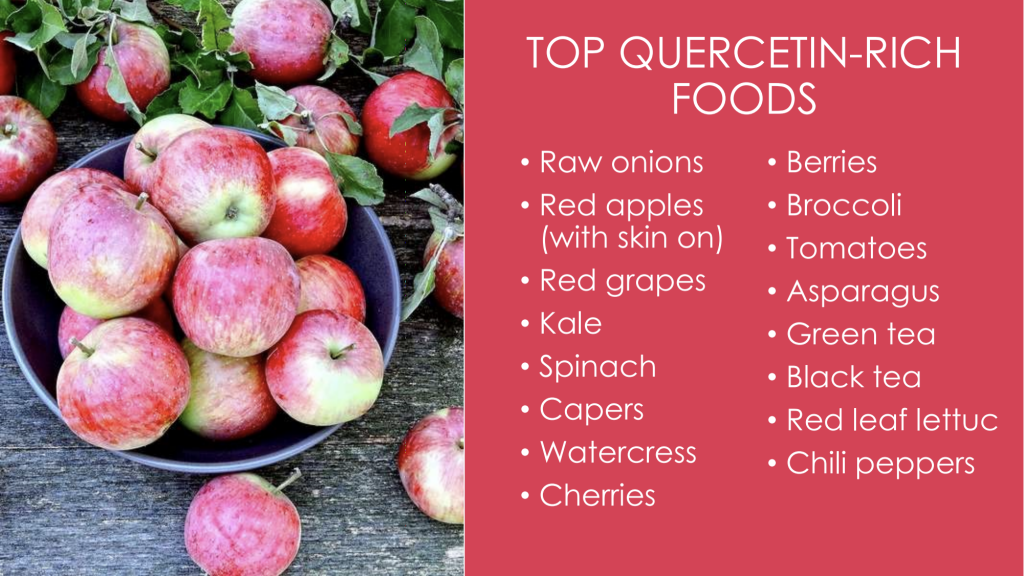
Natural substances that have zinc ionophore activity include polyphenols such as Quercetin and EGCG (found in green tea) (9), and may therefore also have the potential to slow down SARS-CoV-2 replication similar to zinc. Both Quercetin and EGCG were found to inhibit a specific enzyme that is critical for SARS-CoV replication (10). Quercetin may also prevent SARS-COV from entering cells in the first place (11). In addition, Quercetin was found to protect against sepsis and improve survival by inhibiting the NF-kB pathway (12, 13, 14).
VITAMIN C

Vitamin C is one of our most important antioxidants to mop up those free radicals when we’re sick. Vitamin C can significantly reduce the incidence and severity of pneumonia, which is one of the major complications of COVID-19 (15). Vitamin C 1.5 grams IV every 6 hours (6 grams total daily), given with hydrocortisone and thiamine has also been found to significantly decrease mortality and prevent progressive organ failure in patients with sepsis, a primary cause of death in patients with COVID-19. In fact, patients treated with the vitamin C protocol had an 8.5% death rate compared with 40.4% in the control group (16)!
There are several studies in China of high dose IV vitamin C ongoing, with doses ranging from 10-24 grams per day. Preliminary results were reported to show a significant reduction in lung inflammation and duration of hospital stay (17). Reports of high-dose vitamin C being used in China to treat patients with COVID-19 have been met with a flurry of controversy. But the question that needs to be asked is, knowing how important an antioxidant vitamin C is and how protective it can be with sepsis, “What’s the downside?” especially when compared with the dangerous and even fatal side effects of proposed medications to treat COVID-19 like chloroquine?
GLUTATHIONE
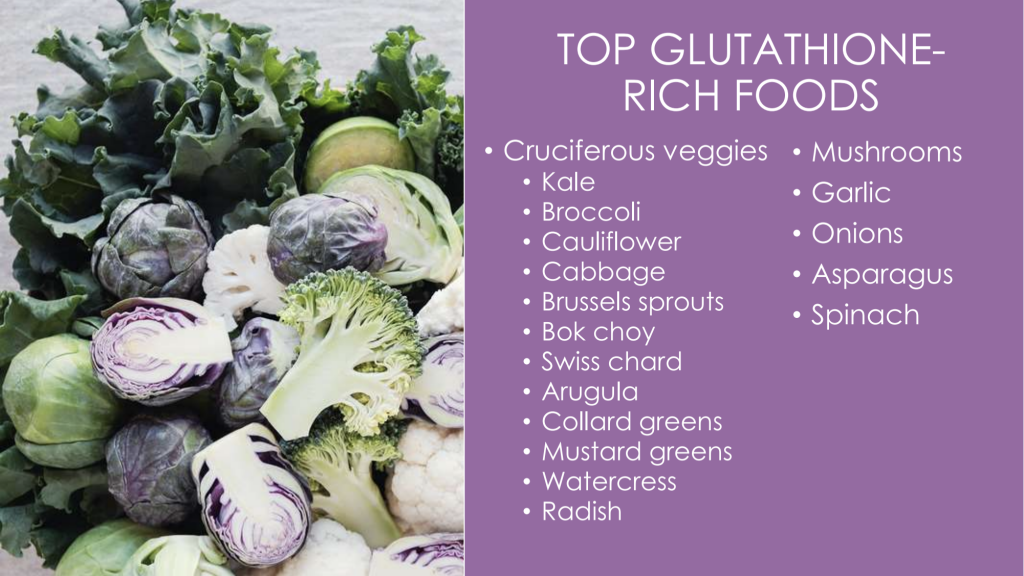
Glutathione is present in all of those yummy, sulfur-rich, cruciferous vegetables. Also note that taking an epsom salt bath (which is magnesium sulfate), can increase your glutathione levels while also boosting magnesium to promote calm during these stressful times. So take the time to indulge yourself in a warm epsom salt bath without the guilt. (P.S. it’s safe for kids too!)
Glutathione is our “master antioxidant,” and is naturally produced in our livers. Glutathione reduces oxidative stress and free radical production (19), which is so important when we’re fighting infections of any sort. Glutathione increases natural killer cell activity (our first line of defense against viral or bacterial infections) (20), and also supports our immune response to viruses, bacteria and parasites (21). Glutathione and it’s precursor N-acetylcysteine (NAC) have been shown to inhibit viral replication (22,23), and depletion of glutathione (for instance by using acetaminophen to reduce fevers) has been found to prolong the duration of viral infections, worsen severity of symptoms, and increase viral shedding from the nasopharynx (see my article NSAIDs & Coronavirus for more information).
VITAMIN D
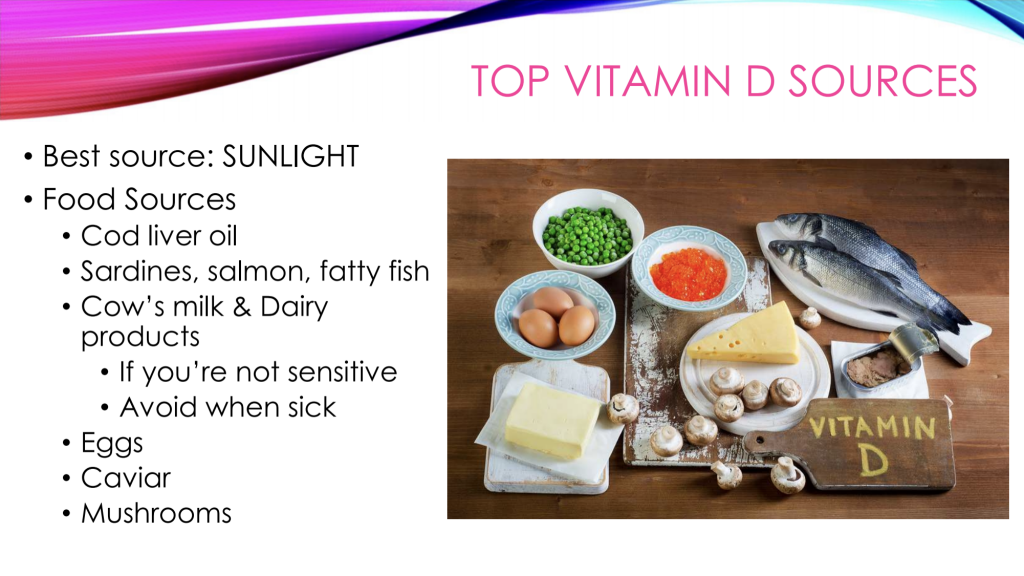
Sunlight is the best way to obtain optimal vitamin D levels, but optimal skin conversion will only occur during the summer months in the Northern Hemisphere. Vitamin D is found naturally in only a few foods, so supplementation is often needed, but absolutely load up on the all the vitamin-D rich foods you can!
Vitamin D has too many immune benefits to fully cite here. Studies have shown that people supplemented with adequate levels of vitamin D3 during the cold and flu season had significantly lower rates of infection. Vitamin D3 increases our body’s production of cathelicidin, an antimicrobial compound, to help fight viral and bacterial infections. Vitamin D deficiency may also be one of the risk factors for sepsis.
Vitamin D has been called a “pro-survival molecule.” In this review of the literature on vitamin D and immunity (25), the authors conclude that:
“vitamin D not only helps the immune system to be dampened during an excessive or chronic reaction (anti-inflammatory potential) but also to rapidly reach its completion or exhaustion, helping innate cells to kill bacteria or viruses. In this sense, vitamin D maintains its pivotal role as a pro-survival molecule.”
Concern has been raised by some that vitamin D3 may increase ACE2 receptor expression and worsen COVID-19, and should therefore be avoided. The theoretical concern is that SARS-CoV-2 attaches to target cells via angiotensin-converting enzyme 2 (ACE2) receptors, and supplements or medications that increase ACE2 receptor expression may allow more SARS-CoV-2 particles to attach to lung cells, potentially leading to more invasive disease. However, some studies have shown the exact opposite – that higher ACE2 levels may actually protect against acute respiratory distress syndrome (ARDS) and sepsis, which is what we’re all very concerned about with COVID-19 infection. In fact, soluble ACE2 is being investigated as a potential therapy for SARS-CoV-2 (26). Read my article NSAIDS & Coronavirus: should we be worried? for my full analysis.
For the moment, knowing that the vast majority of people are vitamin D deficient or insufficient, and knowing how protective vitamin D is for optimal immune system functioning, I continue to believe that vitamin D3 supplementation is an important part of a pandemic immune support protocol. To learn even more, be sure to read my blog, Why All Kids Need Vitamin D.
VITAMIN A

Vitamin A is one of our most important antioxidants, along with vitamin C and glutathione, to mop up free radicals when we’re sick, and help us recover more quickly. As far back as 1928, vitamin A was known as the “anti-infective” vitamin (28). In fact, in regions where vitamin A deficiency may be present, the World Health Organization (WHO) recommends a 2-day high-dose vitamin A protocol to treat measles (29). Vitamin A deficiency has been associated with increased risk for infections including influenza, and one study notes that vitamin A deficiency can be considered a nutritionally acquired immunodeficiency disease (30).
PROBIOTICS
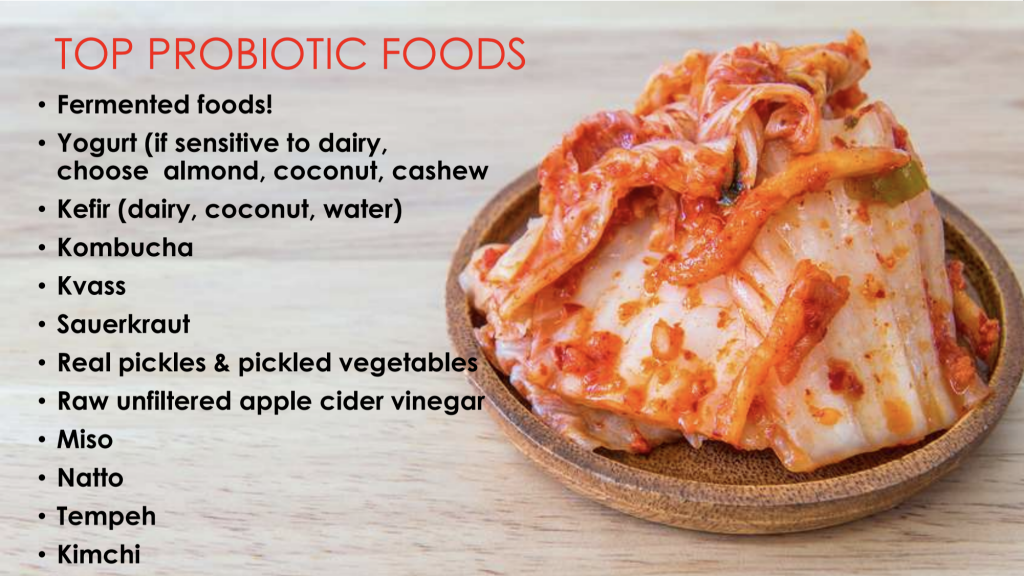
Probiotics are found in fermented foods. Fermented foods pack a bigger probiotic “punch” than any probiotic supplement you can take. In fact, kimchi (one of my faves, and not just because I’m Korean!) was found to kill the H1N1 influenza virus (33)! And if your kids aren’t big fans of fermented foods yet (“yet” is the operative word), keep trying – every forkful of sauerkraut counts!
Probiotics, the “good” bugs in our gut have been found to help us maintain a healthy immune response; support our brain for optimal mood, focus, and attention by producing over 90% of our neurotransmitters, serotonin and dopamine; help with detoxification, and even produce their own antimicrobial and anticancer compounds. Studies of the immune benefits of probiotics are too numerous to list.
OMEGA-3 ESSENTIAL FATTY ACIDS
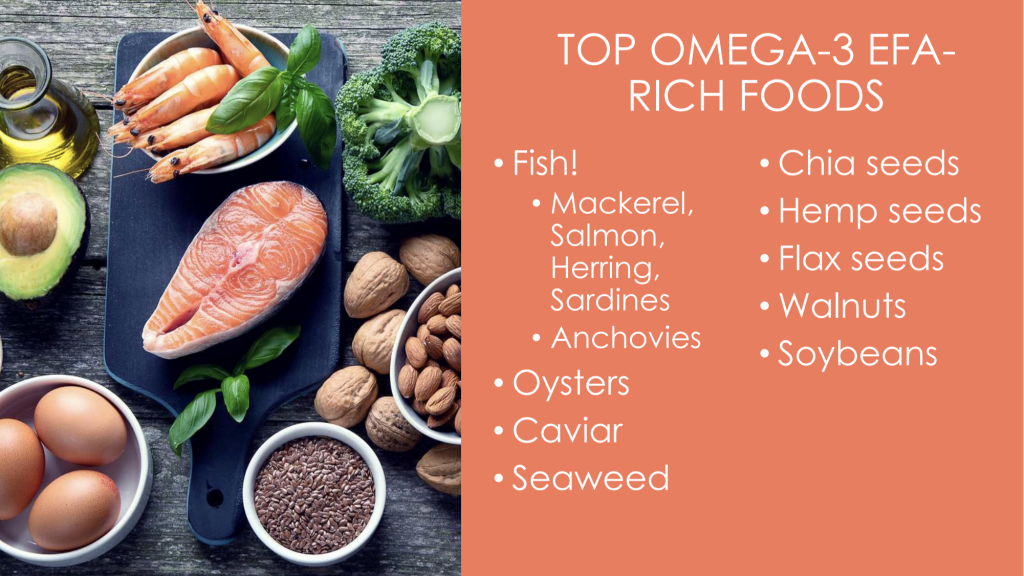
The best food source of the omega-3 essential fatty acids, eicosapentaenoic acid (EPA) and docosahexanoic acid (DHA), is fatty fish. Vegetarian sources of omega-3 fatty acids, like flaxseeds, contain alpha-linolenic acid (ALA) which must be converted to EPA and DHA via the enzyme delta-6-desaturase. Unfortunately, this conversion is not very efficient in most people. So unless you’re a strict vegetarian, I prefer wild-caught, sustainable, fatty fish as a primary source of omega-3 essential fatty acids.
Like vitamin D, the immune benefits of omega-3 essential fatty acids (aka fish oil) are too numerous to list. Omega-3 essential fatty acids reduce inflammation, support healthy immune response, optimize brain and cognitive function, support positive mood, benefit attention and focus, and even gives us healthy skin and hair. Who doesn’t want all of that? Omega-3 essential fatty acids are not just a part of my pandemic immune support plan, they are a part of my family’s year-round plan to stay as healthy and happy as possible.
Immune-Supporting Supplements During the Pandemic
Last but not least – supplements …
While I want to freely share everything I recommend for my family and patients, I must include these very important disclaimers:
- This is for informational purposes only. Any supplement regimen must be individualized to minimize side effects and interactions with any medications you may be taking. Please check with your physician before starting any supplement protocol for you and your child.
- There are NO known natural treatments to prevent or cure COVID-19. There is simply not enough evidence, yet … But, there are also NO known pharmaceutical options. We must look at the evidence that we have from prior research with SARS-CoV and MERS to understand all of our theoretical options for SARS-CoV-2, both natural and pharmaceutical, from a clinically relevant and evidence-based standpoint.
- I only recommend supplements that I use and trust for my family and patients. There are many high-quality supplement manufacturers that may have similar products available, but I can only speak to those that I know personally.
- I have not been paid by any supplement manufacturer to endorse their products.
OK, so with that said, here you go!
ZINC
Potential Zinc Dosages:
The following dosages are based on the Tolerable Upper Intake Levels reported by the NIH (8) and what I use in clinical practice. Please check with your doctor if you take higher amounts. When supplementing with zinc, the most common side effects are nausea and vomiting. High doses of zinc for prolonged periods may deplete copper, which has its own set of health concerns.
- 0-1 year: 4-5 mg daily
- 1-3 years: 5-10 mg daily
- 4-12 years 10-25 mg daily
- 13-18 years: 25-35 mg daily
- 19+ years 25-40 mg daily
QUERCETIN
Potential Quercetin Dosages:
Quercetin as a supplement is generally well-tolerated, and side effects are uncommon at doses of 500-1000mg/day. The most common side effects are stomach upset, headache, and tingling of the arms and legs. When consumed in food, quercetin is safe for pregnant and breastfeeding women. However, there are no studies on safety of quercetin supplements during pregnancy or lactation so please consult with your healthcare provider before taking.
- 2-4 years: 50 mg daily
- 4-8 years: 50-100 mg daily
- 8-12 years: 100-200 mg daily
- 12-18 years: 200-400 mg daily
- 19+ years:400-1000 mg daily
VITAMIN C
Potential Vitamin C Dosages:
Vitamin C is water-soluble, which means you pee out any extra that you don’t need or use. Vitamin C has very low toxicity and even at high doses is very unlikely to be harmful, with the most common side effects being diarrhea, nausea and abdominal cramps. The following suggested dosages do not exceed the the Tolerable Upper Intake Levels reported by the NIH (18); however, higher doses are likely safe.
- 1-5 years: 125-250 mg daily
- 6-12 years: 250-500 mg daily
- 13-18 years: 500-1000 mg daily
- 19+ years: 500-1000+ mg daily
GLUTATHIONE
Potential Glutathione Dosages:
There are no clear guidelines for appropriate glutathione dosage for immune support. These dosages are based on what I typically recommend for patients in my practice. However, patients with chronic illness like asthma or autoimmunity may benefit from higher dosages.
- 1-5 years: 50 mg daily
- 6-12 years: 100 mg daily
- 13-18 years: 200 mg daily
- 19+ years: 250-500 mg daily
Oral glutathione has generally not been found to be well-absorbed, so liposomal glutathione or its precursor, N-acetycysteine, are preferred. Oral liposomal glutathione at doses of 500-1000mg daily have been found to increase blood glutathione levels and reduce oxidative stress within 1 week, and increase Natural Killer cell activity by up to 400% within 2 weeks! (24)
VITAMIN D
Potential Vitamin D Dosages:
The Vitamin D Council recommends a daily maintenance dosage of Vitamin D3 of 1000IU per 25 pounds of body weight, up to 5000IU daily. Given that most children and adults are deficient or insufficient in Vitamin D3, ideally blood levels would be measured to know what dosage is needed to first get to optimal levels and then be able to maintain those levels. In my clinical experience, the ideal 25-OH Vitamin D blood level for optimal immune health is between 60-80 ng/ml.
Vitamin D toxicity can result in abnormal calcium levels and bone loss, kidney stones, and heart calcifications. However, vitamin D toxicity is very unlikely to occur at adult dosages of 10,000IU per day or less (27).
- 0-1 year: 400 IU daily
- 1-6 years: 1,000 IU daily
- 7-12 years: 2,000-3,000 IU daily
- 13-18 years: 3,000-4,000 IU daily
- 19+ years: 5,000 IU daily
VITAMIN A
Potential Vitamin A Dosages:
Vitamin A is a fat-soluble vitamin, which means that it can get stored in your fat and potentially build up to toxic levels. Vitamin A toxicity is uncommon even at higher doses, and is generally seen only with long-term consumption of vitamin A over 25,000-33,000IU (8,000-10,000 mcg RAE) per day (31).
The following dosages are based on the Recommended Daily Allowances and Upper Tolerable Intake level of vitamin A per the Food and Nutrition Board of the US Institute of Medicine (32):
- 0-3 years: 1,000-2,000 IU/day (300-60 0mcg RAE/day)
- 4-8 years: 1,500-3,000 IU/day (450-900 mcg RAE/day)
- 9-13 years: 3,000-5,000 IU/day (1,000-1,500 mcg RAE/day)
- 14+ years: 5,000-10,000 IU/day (1,500-3,000 mcg/RAE/day)
*If you are pregnant, please note that consumption of excess preformed retinol (such as retinyl palmitate and retinyl acetate found in supplements) is known to cause birth defects. No increase in vitamin A-associated birth defects has been seen at doses of preformed vitamin A from supplements below 10,000IU/day (3,000 mcg RAE/day (32). There is NO evidence that consumption of vitamin A from B-carotene in food sources increases the risk of birth defects – so eat all the carrots you want! However, if you would like to take additional vitamin A supplements in the form of retinyl palmitate, please consult with your doctor first.
PROBIOTICS
Potential Probiotic Dosages:
Suggested probiotic doses vary widely depending on the specific health concerns that are being addressed.
One study showed a dramatic reduction in fever and upper respiratory symptoms in children who took a probiotic with a specific combination of Lactobacillus and Bifidobacterium daily throughout the cold and flu season. This particular combination of Lactobacillus and Bifidobacterium can be found in our Immune Probiotic chewable and Immune Probiotic capsules. The recommended dosage for children and adults is 1 chew or 1 capsule 2x/day.
In addition, I also recommend a “broad-spectrum” probiotic with as many different probiotic strains as possible. The gut microbiome looks very similar to an adult microbiome by 2 years of age. That means that all family members over 2 years can take the same probiotic. Children under 2 years should get an infant-specific probiotic.
These are the typical probiotic dosages I use in my practice:
- < 2 years ~ 10-20 billion cfu mixed flora
- > 2 years ~ 20-50 billion cfu mixed flora
If you need help knowing how to pick a high-quality probiotic, please download my free Guide to Choosing Your Child’s Probiotic.
FISH OILS
Potential Omega-3 EFA Dosages:
Fish oil supplements are, in general, very well-tolerated. If you get “fish burps,” try freezing your fish oil capsule before eating. High doses may cause nausea and loose stools, and occasionally easy bruising or bleeding.
The dosages I recommend for my patients vary widely, depending on what else may be going on with their health. And for patients with chronic concerns like asthma, autoimmune conditions, ADHD, anxiety or autism, I may use higher dosages. The following potential doses for immune response are based on a combined EPA + DHA dose:
- 0-1 years: 50-100mg daily
- 1-5 years: 100-500mg daily
- 6-12 years: 500-1,000mg daily
- 13-18 years: 1,000mg daily
- 19+ years: 1000mg+ daily
Dr. Song-Approved Supplements
I am constantly researching and reviewing supplements to make sure that everything I recommend to my patients are of the highest quality. I only recommend those products that I use with my patients and my own children, and trust can help your family thrive! To take the guesswork out. what you and your family need to optimally support your immune systems, I’ve created Immune Support Supplement kits with suggested dosages for kids and adults. As always, check with your physician before starting any new supplement regimen for you or your child.
Be Prepared As Society Reopens
Children continue to make an increasing percentage of new COVID-19 cases as society reopens, and there is concern that children will be our next surge. While the vast majority of children have mild-to-moderate illness and do very well, as many as 5.7-20% of children with COVID-19 may require hospitalization, and 0.58-2% may need ICU care (16). Multisystem Inflammatory Syndrome in Children (MIS-C) and long-haul COVID are rare in children but can be devastating.
💗 I am NOT telling you this to scare you.💗
💗 I AM telling you this because I firmly believe that KNOWLEDGE IS POWER. And that a functional and integrative medicine approach to the pandemic is essential. 💗
By reading this article, you’re already well on your way to supporting your family through the pandemic! If you want even more in-depth information and support, join me in my online program, Integrative & Functional Medicine Strategies for the Pandemic, with live Zoom updates with me continuing through the end of 2021 when you enroll in the VIP option – where I teach you everything I know as a holistic pediatrician and mama who’s had 2 kids recover beautifully from COVID-19, so you can:
💥Stay calm.
💥Be prepared.
💥I’m here to support you and your family.
We’re (still) all in this together!
xo Holistic mama doc – Elisa Song, MD💕
References:
- https://doi.org/10.1093/ajcn/26.11.1180
- https://rupress.org/jem/article/216/3/517/120367/G-s-coupled-receptor-signaling-and-sleep-regulate
- https://www.frontiersin.org/articles/10.3389/fnins.2018.00687/full
- https://www.ncbi.nlm.nih.gov/pubmed/15189121
- https://www.ncbi.nlm.nih.gov/pmc/articles/PMC2973827/
- https://www.ncbi.nlm.nih.gov/pubmed/16042412
- https://www.ncbi.nlm.nih.gov/pmc/articles/PMC4182877/
- https://ods.od.nih.gov/factsheets/Zinc-HealthProfessional/#h8
- https://pubs.acs.org/doi/abs/10.1021/jf5014633
- https://www.ncbi.nlm.nih.gov/pubmed/22350287
- https://jvi.asm.org/content/78/20/11334
- https://www.ncbi.nlm.nih.gov/pubmed/15668926 in a mouse model of sepsis
- https://www.sciencedirect.com/science/article/abs/pii/S1756464619301203
- https://www.ncbi.nlm.nih.gov/pubmed/31377749
- https://www.ncbi.nlm.nih.gov/pubmed/15605943
- https://doi.org/10.1016/j.chest.2016.11.036
- https://www.medicinenet.com/script/main/art.asp?articlekey=228745
- https://ods.od.nih.gov/factsheets/VitaminC-HealthProfessional/
- https://www.ncbi.nlm.nih.gov/pubmed/16224142
- https://www.ncbi.nlm.nih.gov/pubmed/24791752
- https://www.ncbi.nlm.nih.gov/pubmed/23089304
- https://www.ncbi.nlm.nih.gov/pubmed/16787218
- https://www.ncbi.nlm.nih.gov/pubmed/8540746
- https://www.ncbi.nlm.nih.gov/pubmed/28853742
- https://www.clinicaltherapeutics.com/article/S0149-2918(17)30235-7/fulltext
- https://www.ncbi.nlm.nih.gov/pubmed/32167153
- https://www.ncbi.nlm.nih.gov/pubmed/10232622
- https://www.ncbi.nlm.nih.gov/pubmed/15189121
- https://www.ncbi.nlm.nih.gov/pubmed/11869601
- https://www.ncbi.nlm.nih.gov/pubmed/9168553
- https://lpi.oregonstate.edu/mic/vitamins/vitamin-A>
- https://www.nap.edu/read/10026/chapter/6
- https://www.prnewswire.com/news-releases/kimchi-a-well-known-traditional-fermented-korean-food-has-proven-effective-against-influenza-virus-300687023.html
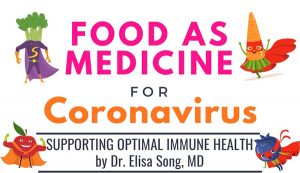
I love this! When things looked like they were getting panicky, I headed to the Korean market and bought 2 gallons of Kimchi. It’s my family’s favorite probiotic 🙂
yes! love kimchi!
Dr. Song,
Thank you so much for all the time you put into these articles! They are so incredibly helpful and reassuring, not just at this challenging time, but always. As a Grandmother, retired nurse and lay homeopathic practitioner that provides the bulk of healthcare to my large family, your blogs are an integral part of my reputable, evidence based, resource package. I felt I could not continue to take advantage of the wealth of up to date information you consistently provide, without expressing my gratitude. Once again, a big thank you and all the best of health and happiness for you and your family!
thank you so much! this warms my heart so much and helps me to keep doing this work!
I heard today on a news report that why children are getting this whereas before it was thought it would be a “slam dunk” that they would not get it is due to, not their age, but the fact that their eating habits are not as good as former generations. More children eat sugary snacks, junk food, and are overweight than before. So this article on lifestyle makes the very important point that lifestyle and diet matter.
yes, food really is medicine – for kids and adults. hopefully we will remember this even once the pandemic is over…
This article has been so helpful!!! I have been researching supplements and dosage for weeks! You have answered so many of my question and I feel so grateful. As a busy mom, I find it so challenging to read and research everything I want to know. Thank you so much!!
I am SO glad you found this information helpful. That’s my mission – to make life as a holistic mama as easy as possible! xo
Thank you so much for all this information!! I have been looking for something like this since all this started. Is it possible to order these supplements through you even if not a patient?
yes – our online Healthy Kids Happy Kids store will be up and running live this week! woo hoo! and anyone can order. for now, you can always email our front office at hello@healthykidshappykids.com and Katie or Adrina can help you!
I notice for the vitamin A you recommend a dose of 1,500-3,000 IU/day (450-900 mcg/day) for 4-8 year olds. But the A drops you recommend have 1,507 mcg in a dose (1 drop). How do you use that one for children if only 1 drop far exceeds what they need daily? Or do you *only* use that vitamin A drop when they are sick and in need of a therapeutic dose?
And if that is the case, what is a good daily vitamin A drop for children that only doses them in the range you recommend?
I have not seen any vitamin a drops that have a lower concentration. The good thing is that Vitamin A is a fat-soluble vitamin, so you could dose it once/week the total amount for that week.
This is absolutely what we need right now. I work on the board of directors for a group of schools and nurseries and will be sharing this with parents. Thank you !
So glad you found it helpful! xo
Thank you for such an informative article. This is actually my third time referring to it, but my first time commenting!
Any recommendation regarding using some of these supplements while also taking cod liver oil? I give my 4.5 year old Rosita oil every other day, and we are also currently doing the Metagenics C and D3 drops and Zinc drops. Usually not full doses. In conjunction with the oil, am I overdoing it? Thanks!
Hi Tobi – great question. Cod liver oil has Vitamin A and Vitamin D, but the amounts of each are not listed as they are difficult to calculate and likely vary from bottle to bottle. I think it would be very difficult to overdose on Vitamin D if you take a cod liver oil and Vitamin D supplement in the recommended ranges (I’ve never seen this in my practice, and I do try to measure my patients’ vitamin D levels when possible). As always – if you’re worried, I would check in with your pediatrician and consider getting D levels checked. Stay well!
Hi, Can you explain why not the Nordic Naturals Gummies?
They taste good, but do not have enough omega-3 essential fatty acid content to be as beneficial as I would like for my patients and children.
I am grateful for this information, and the way you lovingly wrote it.
❤️
thank you so much. xo
I have been using your Supporting optimal immune health guide for the past few weeks.
We have always been eating “healthy” and cleanly but the table you provided makes it so straightforward yet enticing to create super highly nutritional meals. I feel so proud each time I make my three yo a plate that has all the elements. Thanks so much for that and for everything else! The info you provide made me feel less hopeless throughout the past months…
OMG – you just made my day! I LOVE when families can truly use food as medicine! xo Elisa
I see the recommended dose of omega 3 , dha. The recommended dose chart says a combined 1,000 mg for ages 6-12. The metagenocs has over 2,000 mg of combined epa and dha. Is that dose safe for a 7 year old with adhd to take or is it assumed to follow the chart and reduce the serving by half. I know we are still in the pandemic, but would love a detailed article on how to support a child with adhd in hopes of avoiding medication. This is why I’m looking into dha and want to take the maximum therapeutic and safe dose for adhd to reduce symptoms. Thank you !!!
GREAT GREAT WORK.Dr. Song.So much information. Thank you for sharing this with us.I’m forwarding this to others.
I just want to share. Victoria Boutenko, GREEN FOR LIFE & GREEN SMOOTHIES… did a great research. She has a chart of Spring and early summer Omega 3’s greens, veggies, and Fall nuts, squashes, seeds, Omega 6 for winter. Sort of, eat with the seasons. Also, Sharon Moalem, in his book: ”SURVIVAL OF THE SICKEST”writes how we need to load up on sugars as Antifreeze for winters and on Fats to keep us fueled (hybernate) for winters. We becaome diabetic in fall/Winter and High Cholesterol to survive. Not to do blood testing in fall winter we will ALWAYS BE POSITIVE AND then DRUGGED FOR LIFE for conditions that are working with us to survive. Of course, now we make Summer out of Winter with high heat.. Then we make Winter out of Summer with airconditioners. just sharing, as I found this interesting.
Thank you so much for sharing!